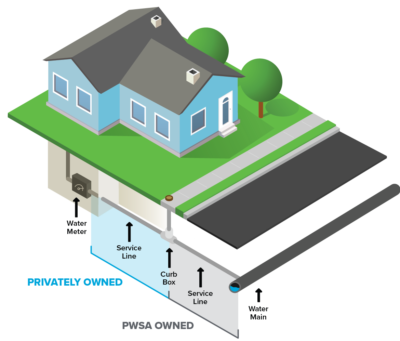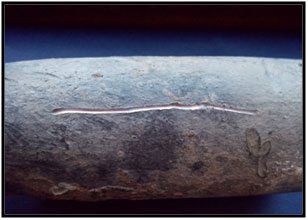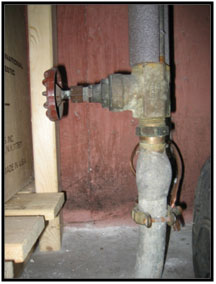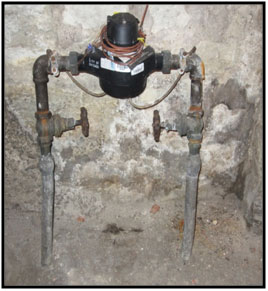Lead is a common metal found in the environment. Historically, because it is so common and because it has a number of qualities that make it easy to work with, lead was used extensively for many things, including construction and plumbing.
Many old water lines throughout Pittsburgh may be made of lead. Exposure to lead in drinking water can cause serious health effects in all age groups. Infants and children can have decreases in IQ and attention span. Lead exposure can lead to new learning and behavior problems or exacerbate existing learning and behavior problems. The children of women who are exposed to lead before or during pregnancy can have increased risk of these adverse health effects. Adults can have increased risks of heart disease, high blood pressure, kidney or nervous system problems.
As research began to reveal the health risks of using lead for various purposes, including plumbing, the use of lead was largely phased out. However, in many homes and cities with older infrastructure, old lead water lines are still in place. Lead and can get into drinking water through corrosion in these older lead service lines—which connect homes to water mains—as well as lead piping or fixtures inside of people’s homes.
Orthophosphate as Corrosion Control
As part of the Pittsburgh Water and Sewer Authority’s Community Lead Response, we are using orthophosphate to reduce lead levels in tap water since spring of 2019. Orthophosphate is a food-grade additive that demonstrated to be very effective at reducing corrosions from lead pipes. To read more about this corrosion control treatment, click here.
This page has the answers to many common questions relating to lead and water. If you have specific questions related to your home that go beyond the scope of these questions, complete the form below, call the Lead Help Desk at 412.255.8987, or email leadhelp@pgh2o.com.
There is no detectable lead in the Pittsburgh Water and Sewer Authority’s water when it leaves the treatment plant and travels through the water mains.
However, lead can enter drinking water through lead services lines and household plumbing. We currently treat drinking water to reduce lead corrosion by applying orthophosphate to treated drinking water. Orthophosphate is widely used across the country to reduce lead in water. We are also working to replace all lead service lines in our system.
It is impossible to completely eliminate the corrosion of old lead water service lines that leads to lead entering the water supply in some homes. Because of this, it is important for our customers to learn how to reduce the risk of exposure to lead in their water.

Lead enters drinking water through corrosion in lead pipes or plumbing materials. The primary source of lead in Pittsburgh Water and Sewer Authority water is the old lead service lines that connect homes to the water main in the street. These service lines are a joint responsibility–the Pittsburgh Water and Sewer Authority owns the portion of the water line that runs between the water main and the curb, and homeowners own the portion that runs between the curb and their homes.
We estimate that 15% of homes in Pittsburgh still have lead water sewer lines.
Aside from lead water service lines, lead can also enter the water through:
- Interior lead pipes
- Interior galvanized pipes (especially if there is or was a lead water service line running to the house)
- Interior copper pipes with lead soldered joints
- Interior plumbing fixtures purchased or installed prior to January 2014 before the effective date of the new definition of “lead free”
If you know or suspect that you have lead service lines or plumbing, there are ways to reduce your exposure to lead in your drinking water:
- Run your water to flush out lead. If you haven’t used your water for several hours, run your cold tap for one minute before using your water for cooking or drinking. If your home has longer lead lines, this may require flushing for a longer period of time. Using toilets, washing clothes, showering, or doing dishes before you drink from your tap are all ways that you can flush your water lines without wasting water.
- Use cold water for cooking and preparing baby formula. Lead dissolves more easily in hot water. Do not drink, cook with, or make baby formula using hot water.
- Do not boil water to remove lead. Boiling water does not remove or reduce lead exposure.
- Look for alternative sources or treatment of water. Purchase a NSF Water Filter that is certified to remove lead from your water. Customers can also choose to drink bottled water.
- Identify if your plumbing fixtures contain lead. Lead check swabs are available at hardware stores to help you detect lead on plumbing surfaces, such as solder and pipes. Consider replacing pipes and fixtures that contain lead.
- Contact us if you decide to replace your lead service line via our Lead Line Reimbursement Program. Depending on your income, you may be eligible to have your lead water service line replaced at no cost.
- Test your water for lead. Call us at 412.255.8987 or click here to request a free lead test kit. This service is available to all PWSA water customers.
- Get your child’s blood tested. If you think that your child may have been exposed to lead, talk to your doctor about testing your child. Allegheny County requires all children to be tested for lead exposure at approximately 9-12 months and again at 24 months.
These are some methods for determining whether or not your water service lines are made from lead:
Lead service lines are generally a dull gray color and are very soft. You can identify them easily by carefully scratching them with a key. If the pipe is made of lead, the area you’ve scratched will turn a bright silver color. Do not use a knife or other sharp instrument, as this could puncture a hole in the pipe.

Lead service lines can be connected to the residential plumbing using solder and have a characteristic solder “bulb” at the end, a compression fitting, or other connector made of galvanized iron or brass/bronze. If you notice these elements, it may mean that your service line is made of lead.

Lead service lines often end just inside the front or side wall of the home, but
may extend further into the building as shown, where the lead service line comes out of the basement floor to the water meter and then back into the floor, continuing further into the building.
 If you are still unsure about the composition of your water service line, or if you have more questions, call the Lead Help Desk at 412.255.8987, or email leadhelp@pgh2o.com.
If you are still unsure about the composition of your water service line, or if you have more questions, call the Lead Help Desk at 412.255.8987, or email leadhelp@pgh2o.com.
Information and graphics prepared by USEPA
We are in the process of identifying and removing lead service lines in public space. As we identify the location of lead service lines, we will make this information available to the public. Customers who want to replace their lead service lines on their own should contact our Lead Help Desk for more information about coordinating efforts.
We have free lead test kits available to all PWSA drinking water customers. Click here to request a kit or call 412.255.8987. After you place the request, your kit will be mailed to you within approximately 14 days. Samples from your tests are then sent to an independent laboratory, and the results will be provided to you directly.
There is more to lead reduction than simply replacing water lines. We are educating customers about lead through distribution of public education brochures and posters through the City of Pittsburgh and Millvale. We are also regularly updating the information on our website, attending local community meetings, and providing outreach via social media.
The EPA requires that we regularly request water samples from at least 100 homes that were determined to have, or are expected to have, a lead water service line or plumbing. Results from the most recent test can be found at www.pgh2o.com/lead-data.
PWSA is embarking on a multi-year program to replace 10-20 miles of water mains and aging service lines per year. As we replace water mains, we will replace hundreds of lead water service lines, improving water quality for many of our customers. While removing the source of lead is the most effective way of reducing the risk of lead in water, it is a long-term project. Our use of orthophosphate in the water treatment process will ensure reduced lead levels for all customers while we work to remove lead lines.
We are also undertaking targeted lead service line programs, replacing all lead service lines within neighborhoods throughout the service area, as well as any lead found at daycare facilities and residences with elevated lead levels.
- To learn more about our water main and lead service line replacement program, click here.
- To learn more about our targeted lead line replacement projects, click here.
- To read more about our use of orthophosphate to reduce lead levels for all customers, click here.
For customers interested in replacing the private portion of their lead service line, we also offer reimbursement for lead service line replacement. This is an income-qualified program that allows customer to hire a private plumber to complete the work and receive reimbursement. If the public portion of the service line is found to be lead also, we will coordinate with your private plumber to replace the public portion at the same time.
- For more information on our Lead Line Reimbursement Program, visit lead.pgh2o.com/leadreimbursement/.
- Run your water to flush out lead. If you haven’t used your water for several hours, run your cold tap for at least one minute before using for cooking or drinking. Homes with longer lead water service lines may require flushing for a longer period of time.
- Use cold water for cooking and preparing baby formula. Lead dissolves more easily in hot water. Do not drink, cook with, or make baby formula using hot water.
- Do not boil water to remove lead. Boiling water will not reduce lead.
- Look for alternative sources or treatment of water. Purchase a water filter that is certified by NSF to remove lead. Coupons for NSF-certified filters can be found here. Customers can also choose to drink bottled water.
- Identify if your plumbing fixtures contain lead. There are commercially-available lead check swabs that can detect lead on plumbing surfaces such as solder and pipes. Consider having lead-containing pipes and fixtures replaced.
- Contact PWSA if you decide to replace your lead service line. Depending on household income, customers may be eligible to have their lead water service line replaced at no cost.
- Test your water for lead. Go to pgh2o.com/leadform or call us at 412-255-8987 to request a free lead test kit. If a test comes back with elevated lead levels, PWSA will send a lead filter free of cost.
- Get your child’s blood tested. If you think your child may have been exposed to lead, talk to you doctor about testing your child. Allegheny County requires all children to be tested for lead exposure at approximately 9-12 months, and again at 24 months.
Many American cities face similar challenges posed by old lead infrastructure. PWSA is committed to working with our community to identify solutions to reduce the risk of lead exposure. The Authority encourages customers to learn more about lead in water at lead.pgh2o.com. Additional information on lead in water, including health risks and protective measures, is available at:
- U.S. EPA Safe Drinking Water Hotline – www.epa.gov/lead
- Centers for Disease Control – www.cdc.gov/nceh/lead/tips/water.htm
- Allegheny County Health Department (ACHD) – www.achd.net/lead
- Pennsylvania DEP www.dep.pa.gov/lead
Other Websites for Lead Safety Information
To request a free customer lead test kit: Call PWSA Lead Help Desk at 412.255.8987 or go to Click here.
For any other questions regarding the lead program, please call the PWSA Lead Help Desk at 412.255.8987 or email at LeadHelp@pgh2o.com.
To receive a discount coupon for a water pitcher certified for lead removal, visit this page.
For more information on lead service line replacement, contact the PWSA Help Desk at 412.255.8987 or via email at LeadHelp@pgh2o.com
